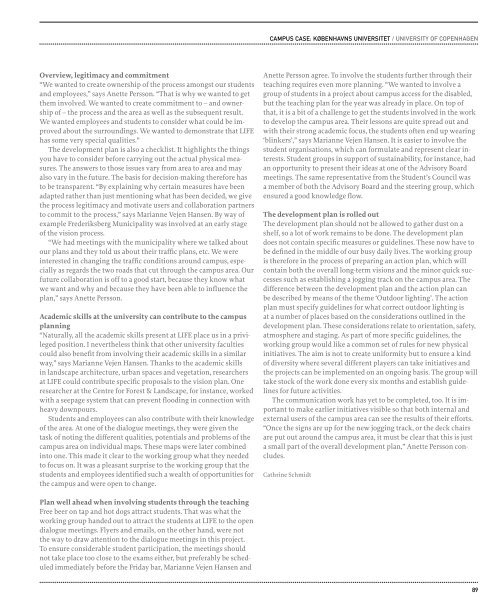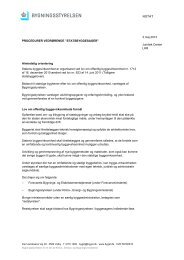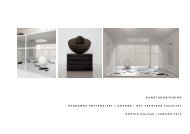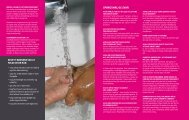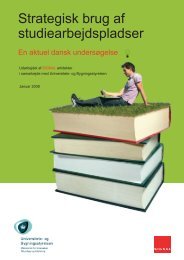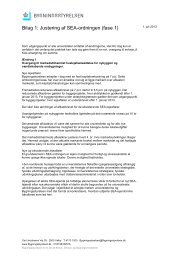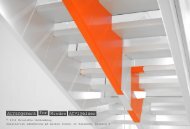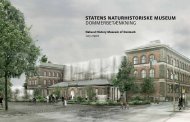Campus og studiemiljø - Bygningsstyrelsen
Campus og studiemiljø - Bygningsstyrelsen
Campus og studiemiljø - Bygningsstyrelsen
You also want an ePaper? Increase the reach of your titles
YUMPU automatically turns print PDFs into web optimized ePapers that Google loves.
overview, legitimacy and commitment<br />
“We wanted to create ownership of the process amongst our students<br />
and employees,” says Anette Persson. “That is why we wanted to get<br />
them involved. We wanted to create commitment to – and ownership<br />
of – the process and the area as well as the subsequent result.<br />
We wanted employees and students to consider what could be improved<br />
about the surroundings. We wanted to demonstrate that LIFE<br />
has some very special qualities.”<br />
The development plan is also a checklist. It highlights the things<br />
you have to consider before carrying out the actual physical measures.<br />
The answers to those issues vary from area to area and may<br />
also vary in the future. The basis for decision-making therefore has<br />
to be transparent. “By explaining why certain measures have been<br />
adapted rather than just mentioning what has been decided, we give<br />
the process legitimacy and motivate users and collaboration partners<br />
to commit to the process,” says Marianne Vejen Hansen. By way of<br />
example Frederiksberg Municipality was involved at an early stage<br />
of the vision process.<br />
“We had meetings with the municipality where we talked about<br />
our plans and they told us about their traffic plans, etc. We were<br />
interested in changing the traffic conditions around campus, especially<br />
as regards the two roads that cut through the campus area. Our<br />
future collaboration is off to a good start, because they know what<br />
we want and why and because they have been able to influence the<br />
plan,” says Anette Persson.<br />
academic skills at the university can contribute to the campus<br />
planning<br />
“Naturally, all the academic skills present at LIFE place us in a privileged<br />
position. I nevertheless think that other university faculties<br />
could also benefit from involving their academic skills in a similar<br />
way,” says Marianne Vejen Hansen. Thanks to the academic skills<br />
in landscape architecture, urban spaces and vegetation, researchers<br />
at LIFE could contribute specific proposals to the vision plan. One<br />
researcher at the Centre for Forest & Landscape, for instance, worked<br />
with a seepage system that can prevent flooding in connection with<br />
heavy downpours.<br />
Students and employees can also contribute with their knowledge<br />
of the area. At one of the dial<strong>og</strong>ue meetings, they were given the<br />
task of noting the different qualities, potentials and problems of the<br />
campus area on individual maps. These maps were later combined<br />
into one. This made it clear to the working group what they needed<br />
to focus on. It was a pleasant surprise to the working group that the<br />
students and employees identified such a wealth of opportunities for<br />
the campus and were open to change.<br />
Plan well ahead when involving students through the teaching<br />
Free beer on tap and hot d<strong>og</strong>s attract students. That was what the<br />
working group handed out to attract the students at LIFE to the open<br />
dial<strong>og</strong>ue meetings. Flyers and emails, on the other hand, were not<br />
the way to draw attention to the dial<strong>og</strong>ue meetings in this project.<br />
To ensure considerable student participation, the meetings should<br />
not take place too close to the exams either, but preferably be scheduled<br />
immediately before the Friday bar, Marianne Vejen Hansen and<br />
<strong>Campus</strong> Case: køBenHavns universitet / university oF CopenHagen<br />
Anette Persson agree. To involve the students further through their<br />
teaching requires even more planning. “We wanted to involve a<br />
group of students in a project about campus access for the disabled,<br />
but the teaching plan for the year was already in place. On top of<br />
that, it is a bit of a challenge to get the students involved in the work<br />
to develop the campus area. Their lessons are quite spread out and<br />
with their strong academic focus, the students often end up wearing<br />
‘blinkers’,” says Marianne Vejen Hansen. It is easier to involve the<br />
student organisations, which can formulate and represent clear interests.<br />
Student groups in support of sustainability, for instance, had<br />
an opportunity to present their ideas at one of the Advisory Board<br />
meetings. The same representative from the Student’s Council was<br />
a member of both the Advisory Board and the steering group, which<br />
ensured a good knowledge flow.<br />
the development plan is rolled out<br />
The development plan should not be allowed to gather dust on a<br />
shelf, so a lot of work remains to be done. The development plan<br />
does not contain specific measures or guidelines. These now have to<br />
be defined in the middle of our busy daily lives. The working group<br />
is therefore in the process of preparing an action plan, which will<br />
contain both the overall long-term visions and the minor quick successes<br />
such as establishing a j<strong>og</strong>ging track on the campus area. The<br />
difference between the development plan and the action plan can<br />
be described by means of the theme ‘Outdoor lighting’. The action<br />
plan must specify guidelines for what correct outdoor lighting is<br />
at a number of places based on the considerations outlined in the<br />
development plan. These considerations relate to orientation, safety,<br />
atmosphere and staging. As part of more specific guidelines, the<br />
working group would like a common set of rules for new physical<br />
initiatives. The aim is not to create uniformity but to ensure a kind<br />
of diversity where several different players can take initiatives and<br />
the projects can be implemented on an ongoing basis. The group will<br />
take stock of the work done every six months and establish guidelines<br />
for future activities.<br />
The communication work has yet to be completed, too. It is important<br />
to make earlier initiatives visible so that both internal and<br />
external users of the campus area can see the results of their efforts.<br />
“Once the signs are up for the new j<strong>og</strong>ging track, or the deck chairs<br />
are put out around the campus area, it must be clear that this is just<br />
a small part of the overall development plan,” Anette Persson concludes.<br />
Cathrine Schmidt<br />
89


